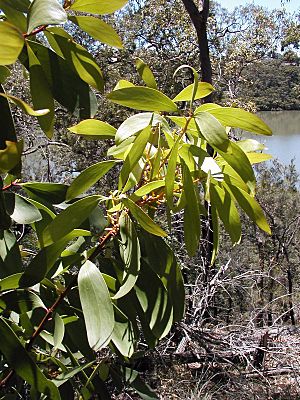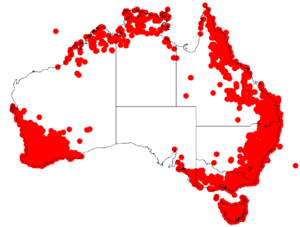Snottygobble facts for kids
Quick facts for kids Snottygobble |
|
|---|---|
 |
|
| Persoonia levis | |
| Scientific classification |
|
| Kingdom: | Plantae |
| Clade: | Tracheophytes |
| Clade: | Angiosperms |
| Clade: | Eudicots |
| Order: | Proteales |
| Family: | Proteaceae |
| Subfamily: | Persoonioideae |
| Tribe: | Persoonieae |
| Genus: | Persoonia Sm. |
| Type species | |
| Persoonia lanceolata |
|
| Species | |
|
See text |
|
 |
|
| Occurrence data downloaded from AVH | |
| Synonyms | |
|
|
Persoonia, also known as geebungs or snottygobbles, is a group of about one hundred types of flowering plants. They belong to the Proteaceae plant family. These plants are usually shrubs or small trees. They often have smooth bark and simple leaves. Their flowers are usually yellow and grow along a stem. Each flower has a small leaf or scale at its base. The fruit of a Persoonia plant is a drupe, which is a fleshy fruit with a hard seed inside.
Contents
What do Persoonia Plants Look Like?
Persoonia plants are mostly shrubs, but some can grow into small trees. They usually have smooth bark. Their leaves are simple, meaning they are not divided into smaller leaflets. The leaves are often arranged one after another along the stem. Sometimes, they grow in pairs or in groups of three or four around the stem. If a leaf has a stalk, it is usually short.
The flowers grow either by themselves or in groups along a stem, called a raceme. These flower groups can be found where leaves join the stem or at the ends of branches. Sometimes, the flower stem keeps growing into a leafy shoot. The parts of the flower that look like petals, called tepals, are mostly separate. Their tips are often rolled back, and they are usually yellow. Each flower has one stigma (the part that receives pollen) on top of the ovary. This stigma is surrounded by four stamens (the parts that produce pollen). The fruit is a drupe, which holds one or two seeds inside.
Naming and History of Persoonia
The name Persoonia was first officially given to this group of plants in 1798. It was named by James Edward Smith. He named it after Christiaan Hendrik Persoon, a Dutch expert in fungi and plants.
The common name "geebung" comes from the geebung word in the Dharug language. This language was spoken by Aboriginal people in the Sydney area. Another Aboriginal term for these plants, from the Wiradjuri people, was jibbong.
The name "snottygobble" is a bit stranger. In the past, this name was used for the fruit of the yew tree. Children would eat the red parts of these berries. The fruit of Persoonia plants has a soft, sweet pulp around a hard stone. It is safe to eat, though some people describe eating it as "like nibbling sweet cotton wool."
Scientists have studied the genes of these plants. They found that some other plant groups, like Toronia, Garnieria, and Acidonia, are actually part of the larger Persoonia group.
Where do Persoonia Plants Grow?
Most Persoonia species are found only in Australia. However, one species, Persoonia toru, also grows in New Zealand. In Australia, you can find them in many areas that are not too dry. One species, P. pertinax, lives only in the Great Victoria Desert. A few others can grow in dry areas, but most prefer places with a subtropical to temperate climate. This includes parts of southeastern and southwestern Australia, and also Tasmania.
Most Persoonia plants grow best in soils that drain water well. They like sandy or sandstone-based soils that are low in nutrients and a bit acidic. One species, Persoonia graminea, is unusual because it grows in swampy places. A few species can handle slightly chalky soils. Some southeastern species sometimes grow on soils made from basalt rock. The largest number of different Persoonia species are found where the soils come from sandstones and granites.
How Persoonia Plants are Pollinated
The flowers of Persoonia plants are pollinated by native bees. Bees from the Leioproctus group are especially important, like L. speculiferus. The common honey bee (Apis mellifera), which was brought to Australia, also helps to pollinate these plants.
Images for kids
-
Persoonia pinifolia fruit
-
Persoonia levis bark
-
Persoonia coriacea shrub on road verge, near Yellowdine WA
See also
 In Spanish: Geebungs para niños
In Spanish: Geebungs para niños





